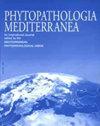Characterization of Stemphylium spp. associated with tomato foliar diseases in Algeria
IF 1.9
3区 农林科学
Q2 AGRONOMY
引用次数: 2
Abstract
Leaf blight and spot caused by Stemphylium spp. and Alternaria spp. are the most common destructive tomato diseases in north-western Algeria. During 2018 growing seasons, more than 30% of samples collected from plants grown in greenhouses or open fields were infected with Stemphylium. Initial symptoms were small, multiple, irregular to oval, yellow leaf spots, which enlarged to brown lesions later. In these lesions, Stemphylium mostly co-occurred with Alternaria spp. Twenty nine Stemphylium isolates were characterized based on morphological features, and multi-locus phylogenies using ITS, gpd, and cmdA genomic loci. Five Stemphylium species (S. lycopersici, S. gracilariae, S. eturmiunum, S. vesicarium, S. lycii) were associated with tomato leaf spot, of which S. lycii is a new report for tomato. Pathogenicity tests on healthy 2-months-old tomato seedlings reproduced symptoms similar to those observed in tomato crops. The tested fungus isolates differed in pathogenicity. Two isolates of S. lycopersici were more aggressive than those of the other species, causing major lesions on tomato plants. The five identified Stemphylium species are reported for the first time as new pathogens for tomato in Algeria, and S. lycopersici, S. gracilariae, S. eturmiunum, and S. lycii as new species of Algerian mycoflora.阿尔及利亚番茄叶面病害相关茎蚜的鉴定
番茄叶枯病和斑点病是阿尔及利亚西北部最常见的破坏性番茄疾病。在2018年的生长季节,从温室或开阔地种植的植物中采集的样本中,有30%以上感染了甜菊。最初的症状是小的、多发的、不规则到椭圆形的黄色叶斑,后来扩大到棕色病变。在这些病变中,甜菊主要与链格孢菌共发生。根据形态学特征和ITS、gpd和cmdA基因组位点的多位点系统发育对29个甜菊分离株进行了表征。番茄叶斑病与五种甜菊属植物有亲缘关系,其中甜菊属是番茄的新报道。对健康的2个月大的番茄幼苗进行的致病性测试再现了与番茄作物相似的症状。测试的真菌分离株的致病性不同。番茄的两个分离株比其他物种的分离株更具攻击性,对番茄植株造成重大损害。在阿尔及利亚,首次报道了五种已鉴定的甜菊属植物作为番茄的新病原体,并报道了番茄S.lycopersici、Graciliae、S.eturmiunum和S.lycii作为阿尔及利亚真菌区系的新物种。
本文章由计算机程序翻译,如有差异,请以英文原文为准。
求助全文
约1分钟内获得全文
求助全文
来源期刊

Phytopathologia Mediterranea
生物-植物科学
CiteScore
4.40
自引率
8.30%
发文量
28
审稿时长
6-12 weeks
期刊介绍:
Phytopathologia Mediterranea is an international journal edited by the Mediterranean Phytopathological Union. The journal’s mission is the promotion of plant health for Mediterranean crops, climate and regions, safe food production, and the transfer of new knowledge on plant diseases and their sustainable management.
The journal deals with all areas of plant pathology, including etiology, epidemiology, disease control, biochemical and physiological aspects, and utilization of molecular technologies. All types of plant pathogens are covered, including fungi, oomycetes, nematodes, protozoa, bacteria, phytoplasmas, viruses, and viroids. The journal also gives a special attention to research on mycotoxins, biological and integrated management of plant diseases, and the use of natural substances in disease and weed control. The journal focuses on pathology of Mediterranean crops grown throughout the world.
The Editorial Board of Phytopathologia Mediterranea has recently been reorganised, under two Editors-in-Chief and with an increased number of editors.
 求助内容:
求助内容: 应助结果提醒方式:
应助结果提醒方式:


